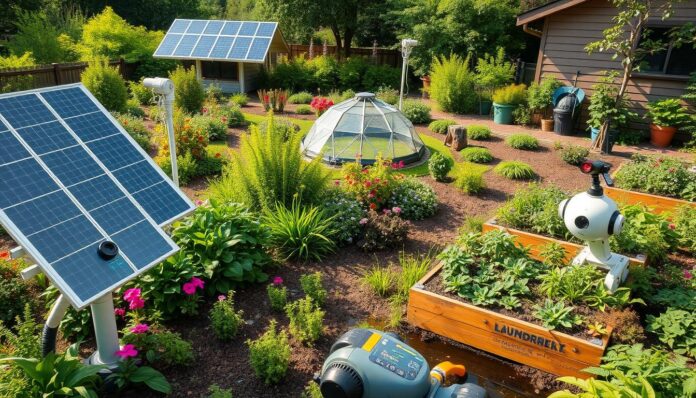Are you ready to change agriculture with new technology and green design? Permaculture automation is a new way to farm. It mixes nature’s rules with the latest tech.
Today’s permaculture is more than old-school gardening. It’s about using tech to change how we grow food and care for the earth. This guide shows how tech is changing farming big time.
With solar water pumps and smart tools, permaculture automation is a game-changer. It helps farms work better and keep nature in balance. By using tech, farmers can use less water, grow more food, and make farms stronger.
Key Takeaways
- Technology is transforming traditional permaculture practices
- Automated systems can dramatically improve agricultural efficiency
- Smart technologies enable more sustainable resource management
- Permaculture automation reduces environmental impact
- Innovative tools help farmers make data-driven decisions
Understanding Permaculture Principles
Permaculture is a new way to farm that’s better for the planet. It was started in 1970 by Bill Mollison from Australia. This method uses nature and human ideas to make farms that can take care of themselves.
Definition of Permaculture
Permaculture is all about holistic design. It mixes permanent farming with living green. The name “permaculture” comes from “permanent” and “agriculture.” It shows how it aims to make farms that last forever and work with nature.
“Permaculture is an integrated, evolving system of perennial or self-perpetuating plant and animal species useful to humans” – Bill Mollison
Importance of Sustainability
Permaculture uses new tech to change farming. This tech brings big benefits:
- It cuts down on farming costs by using less outside help
- It makes sure nothing goes to waste by recycling everything
- It helps the soil stay healthy without chemicals
- It makes the environment cleaner
The Ethics of Permaculture
Permaculture follows three main rules:
- Earth Care: It’s all about keeping nature safe and healthy
- People Care: It helps communities and makes sure everyone is okay
- Fair Share: It shares extra resources and chances fairly
By mixing these ethics with new farming tech, permaculture finds smart ways to help the planet and people.
The Role of Technology in Permaculture
Permaculture design is getting a tech boost, mixing old wisdom with new tech. Regenerative agriculture automation is changing farming for the better. It makes farming smarter and more efficient.
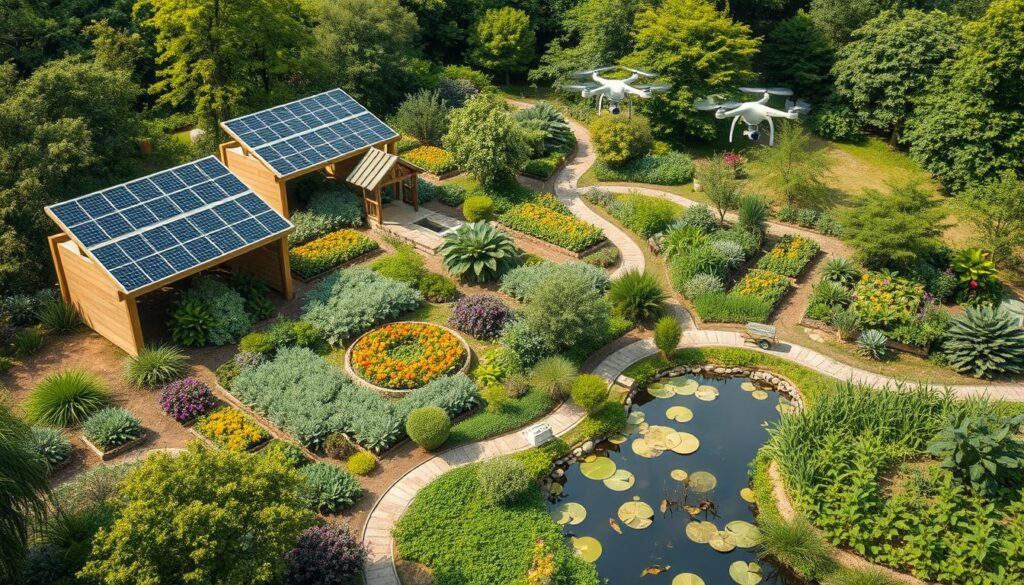
Today’s permaculture folks are using tech to improve farming. They’re using smart tools to change how we farm. This is making farming more ecological and effective.
Integration of Modern Tools
New tech is changing permaculture in big ways:
- Precision agriculture sensors for real-time crop monitoring
- Drone technology for landscape assessment
- Advanced soil health monitoring systems
- Smart irrigation technologies
Advancing Traditional Practices
Technology doesn’t replace nature’s wisdom—it amplifies our understanding and interaction with ecological systems.
Automation in regenerative agriculture gives farmers new insights. It helps them manage resources better while keeping permaculture’s core values.
| Technology | Efficiency Improvement | Resource Conservation |
|---|---|---|
| Soil Moisture Sensors | 30% Water Optimization | Reduced Water Waste |
| Drone Monitoring | 25% Crop Health Tracking | Precise Intervention |
| Automated Irrigation | 40% Water Management | Targeted Watering |
Closed-loop farming is now within reach thanks to tech. Smart tools help permaculture designers make farming better and more productive.
Soil Management Techniques
Permaculture is changing farming with smart systems that focus on soil health. The FAO warns that 90% of topsoil could be lost by 2050. This makes soil preservation very urgent.
Now, farmers use tech to care for their soil better. Digital tools help track soil health, cutting down manual work by 80%. This is thanks to advanced mapping and management tools.
Soil Health Monitoring Tools
Advanced sensors are changing how we manage soil. These tools give farmers real-time data on soil health. This helps them make better choices for their crops.
- Geocomputational mapping technologies
- Digital soil sensors
- Remote monitoring systems
- 3D soil survey data platforms
Composting Innovations
Composting has become more efficient with new tech. Farmers can now turn organic waste into nutrients better than ever before. This is thanks to eco-friendly automation.
| Composting Method | Efficiency | Carbon Reduction |
|---|---|---|
| Automated Vermicomposting | 85% | 30% lower emissions |
| Thermal Composting Systems | 92% | 45% lower emissions |
Biochar Applications
Biochar technology offers transformative potential for soil restoration. It makes soil better, holds water, and captures carbon. This is a big step forward for sustainable farming.
“Biochar is not just a soil amendment; it’s a pathway to regenerative ecosystem design.” – Permaculture Research Institute
By using these new soil management methods, farmers can make farms that are strong and productive. These farms help the environment and ensure food for everyone.
Water Conservation Systems
Water is essential for any sustainable farm. New farming tech has changed how we manage water. It makes systems smarter for saving and using water better.
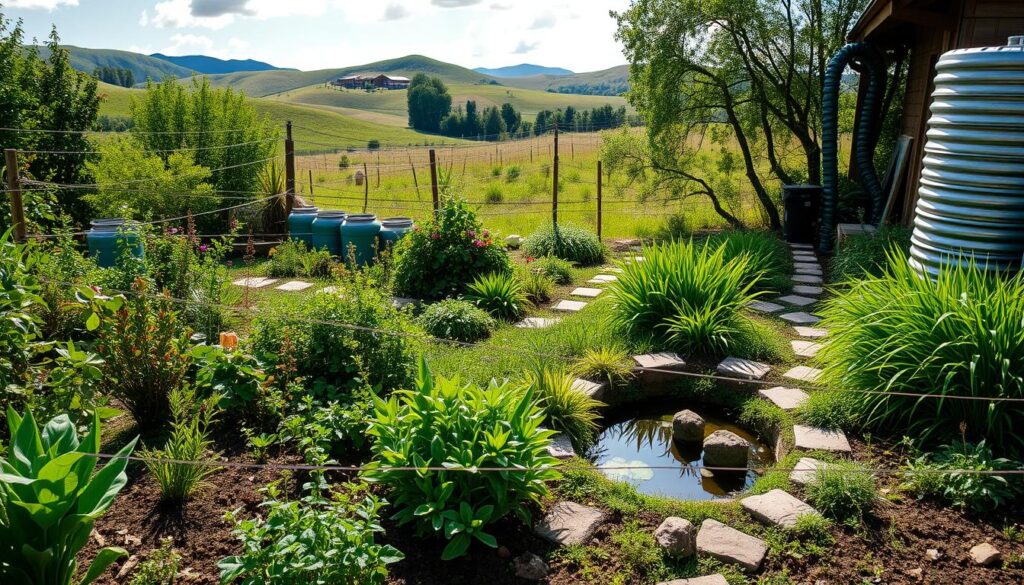
Now, permaculture uses smart tech to manage water. This tech helps track, collect, and spread water in farms.
Rainwater Harvesting Solutions
Modern ways to catch rainwater cut down on using city water. Key methods include:
- Roof collection systems
- Underground storage tanks
- Smart sensor-controlled networks
Greywater Recycling Technologies
Greywater systems are key for saving water. They can cut water use by about 40% if used right.
Intelligent Irrigation Technologies
Smart irrigation systems are top in farming tech. Drip irrigation can save 30-70% of water compared to old ways.
| Water Management Technique | Water Savings Percentage |
|---|---|
| Drip Irrigation | 30-70% |
| Greywater Recycling | 40% |
| Rainwater Harvesting | 50% |
“Water is the driving force of all nature.” – Leonardo da Vinci
Using these new water-saving methods, permaculture can make farms that use water well. These farms can handle changes in the environment.
Energy Efficiency in Permaculture
Permaculture automation changes how we manage energy in farming. It uses renewable energy and smart design. This makes farms efficient and self-sufficient.
At the heart of permaculture’s energy efficiency is using resources wisely. Automated systems use new tech to save energy and boost farm output.
Renewable Energy Sources
New energy tech is changing farming. Key methods include:
- Solar panels
- Wind turbines
- Biomass energy
- Micro-hydro power
Energy Storage Solutions
Good energy storage keeps power steady in farms. New battery tech and smart grids help farmers:
- Save extra energy
- Manage power well
- Need less outside power
“Energy efficiency in permaculture is about creating closed-loop systems that generate, store, and utilize energy with minimal waste.” – Sustainable Agriculture Research Institute
Passive Solar Design
Passive solar design is key in permaculture. It involves smart building placement and natural heat use. Farmers can:
- Use less energy for heating and cooling
- Improve building heat
- Need less artificial climate control
| Energy Strategy | Efficiency Improvement | Resource Reduction |
|---|---|---|
| Solar Panel Integration | 70% Energy Self-Sufficiency | Reduced Grid Dependency |
| Passive Solar Design | 50% Climate Control Savings | Lower Electricity Consumption |
| Biomass Energy | 60% Renewable Energy Generation | Decreased Fossil Fuel Use |
Using all energy-saving strategies makes permaculture farms great examples of green farming.
Community and Social Aspects
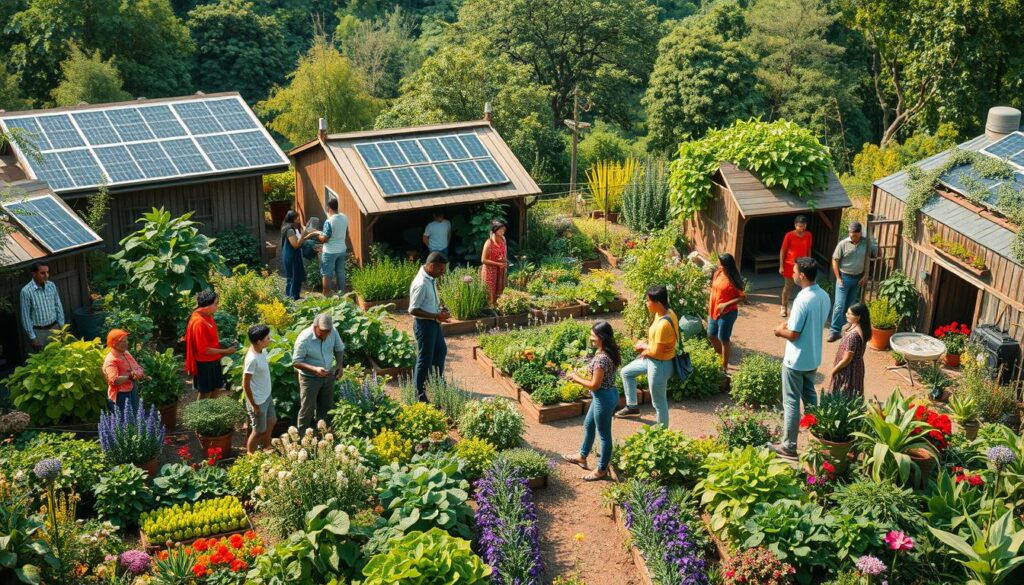
Permaculture has grown from solo efforts to a worldwide movement. Now, technology links communities and shares self-sustaining agricultural technology far and wide.
Collaborative Technology Platforms
Digital tools have changed how permaculture robotics experts work together. These networks help share knowledge, solve problems, and build global communities.
- Online forums for sustainable farming
- Cloud tools for design and planning
- Social media groups for permaculture fans
- Virtual spaces for teamwork
Educational Resources
Thanks to the internet, learning about permaculture is easier than ever. Online classes, webinars, and interactive training reach people everywhere.
“Technology bridges knowledge gaps, transforming permaculture from local practice to global movement.”
Networking Opportunities
Online events, global symposiums, and digital meetups are key for sharing self-sustaining agricultural technology. They help people from different cultures work together and push technology forward.
- International online permaculture conferences
- Digital skill-sharing workshops
- Global research collaboration platforms
- Open-source technology development networks
Designing Permaculture Layouts
Permaculture design has seen a big change with new tech. Now, making and managing farms is easier and faster. Advanced software and apps have made it all more intuitive and efficient.
Digital tools have changed the game in farming design. They offer unmatched precision and creativity. Designers can now use top-notch software to make the most of land and resources.
Technology-Driven Design Software
Modern permaculture design software has amazing features:
- Geographic Information System (GIS) integration for detailed landscape analysis
- Drag-and-drop functionality for easy element placement
- Climate and soil type compatibility assessments
- Plant database with recommended species interactions
Mobile Applications for Garden Planning
Mobile apps have made permaculture design easy for all. Keyline design principles are now simple to follow. These apps guide users through complex designs.
“Technology is bridging the gap between complex ecological design and practical implementation.”
Popular mobile apps have cool features like:
- Real-time sun path analysis
- 3D visualization of garden layouts
- Plant compatibility recommendations
- Water management simulations
By using these tech advancements, permaculture experts can make farms more sustainable and productive.
Biodiversity Monitoring and Management
Intelligent farming systems are changing how we protect nature. Now, permaculture experts use new tech to watch over and care for ecosystems with great detail.
Today’s eco-friendly farming tools help track changes in the environment. They support biodiversity. Farmers can get live data about their land with these advanced methods.
Drones and Aerial Surveillance
Drones have made a big difference in watching over nature. They have high-tech cameras and sensors. They can:
- Map ecosystem boundaries
- Track animal populations
- Detect landscape changes
- Monitor plant health
Data Analytics for Ecosystems
Advanced data tools help us understand ecosystems better. These smart farming systems work with lots of data. They give us useful information to act on.
| Monitoring Metric | Technological Impact |
|---|---|
| Crop Yields | 30% Potential Increase |
| Irrigation Efficiency | 50% Water Usage Reduction |
| Pest Management | 40% Faster Response Times |
Species Identification Apps
New apps use AI for quick species ID. These apps help scientists and farmers quickly list and track biodiversity.
“Technology is bridging the gap between human observation and comprehensive ecological understanding.” – Environmental Tech Research Institute
By using these new tools, permaculture experts can make farming better. They can grow food that meets human needs and protects nature.
The Future of Permaculture Technology
Agriculture is at a turning point. Sustainable farming and bio-integrated automation are changing how we grow food. The next ten years will bring new technologies that will change farming and food management.
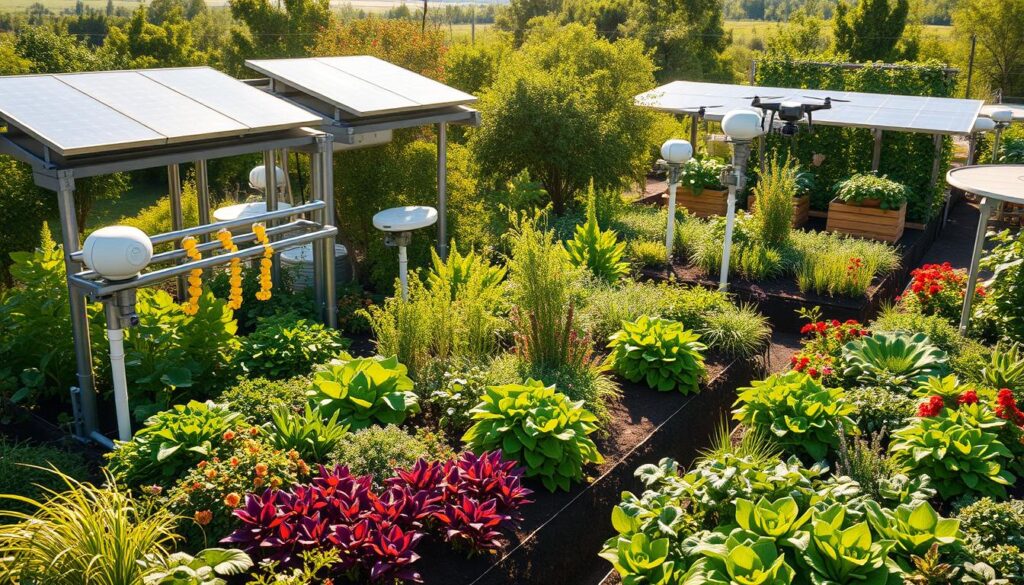
Permaculture technology is getting exciting. By 2050, we’ll need 70% more food. This will push us to innovate more in sustainable farming.
Emerging Technological Frontiers
- AI-driven crop management systems
- Advanced robotics for precision harvesting
- Nanotechnology for targeted pest control
- Bioengineered plant varieties optimized for resilience
Research and Development Priorities
There are key areas for sustainable farming automation research:
- Enhanced energy efficiency in agricultural systems
- Advanced biodiversity preservation techniques
- Development of sophisticated closed-loop agricultural ecosystems
*”The future of agriculture lies not in dominating nature, but in collaborating with its intricate systems.”*
IoT technologies are speeding up this change. By 2023, 70 million agricultural IoT devices will be used. They help monitor soil, crops, and the environment in real-time, making farming smarter.
Integrating sustainable farming automation is crucial for global food security. It also helps reduce environmental harm. Bio-integrated automation combines technology with nature, creating a balanced approach.
Case Studies in Permaculture Technology
Modern agriculture is changing fast with permaculture automation. Autonomous farming systems are growing by 30% each year. This shows how new ways are changing how we grow food.
Real-world examples show how automated permaculture systems can solve big problems in farming.
California’s Sage Mountain Farm is a great example. They use advanced sensors and robots to cut labor costs by 40%. This shows how tech can help manage resources, check soil health, and protect the environment.
Successful Applications in the U.S.
In Colorado, Boulder Valley Farm has seen big changes with precision agriculture. Drones and AI help farmers watch over crops and make smart choices. This has boosted crop yields by 25% and cut down on water and chemicals.
Lessons Learned from Global Practices
Looking at farms worldwide, we learn important lessons. Technology is powerful, but it must work with traditional farming wisdom. The best projects use new tools to support, not replace, the basics of farming.

